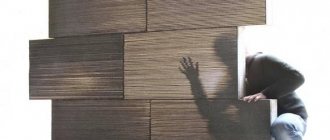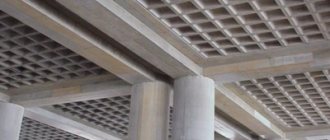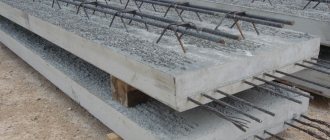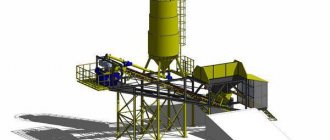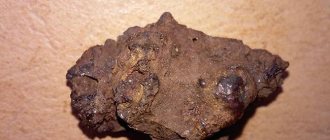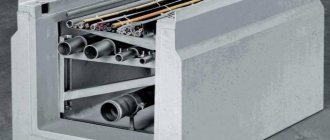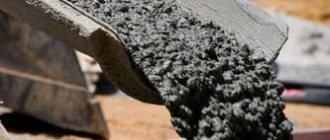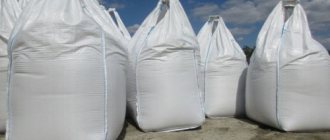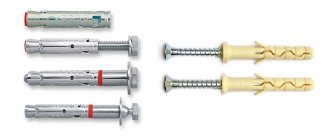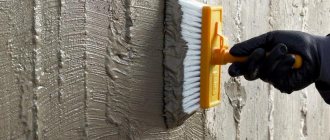Beton-House.com
Website about concrete: construction, characteristics, design. We combine the experience of professionals and private craftsmen in one place
Production of silicate concrete
Silicate concrete belongs to the group of cement-free autoclave-hardening concrete solutions prepared on the basis of lime-silica binders in combination with various mineral fillers. The quality of this type of concrete is regulated by GOST 25214-82 and must comply with the requirements and standards of this document.
- Autoclave processing of silicate products Autoclave design
- Silicate wall material - brick
What is silicate concrete?
In appearance, silicate concrete is a light gray viscous substance, the basis of which is silica compounds and limestone, as well as calcium oxide hydrate contained in quartz sand. As the components are combined, a chemical reaction occurs to form calcium hydrosilicate, which holds the monolith together and connects all the components together.
Activation of substances occurs during autoclave treatment, when pressure with increasing temperature causes the transition of water into a vapor state and its constant presence in the air. The properties of silicate concrete resemble those of standard concrete mortars.
Autoclave for silicate concrete products
There are significant differences between this material and cement concrete:
- the silicate mixture is impregnated with silicon compounds that repel moisture, so silicate concrete is quite waterproof;
- the increased content of calcium oxide or slag additives provides excellent resistance to the influence of aggressive factors;
- the material has many pores that can be filled with gas, liquid, foam to produce new solutions (foam silicates, gas silicates).
Building materials banned in the Russian Federation - is asbestos harmful?
Mesothelioma refers to a cancerous tumor that forms and develops in the mesothelium of the abdominal organs or lungs. The most common forms of mesothelioma are pleural mesothelioma and peritoneal mesothelioma. The pleura is a film that is located between the chest and lungs.
It has been known for over a hundred years that asbestos is harmful to health. The dangers of asbestos were first reported back in 1898, and a year later it was stated that pulmonary fibrosis was caused by asbestos dust. In 1927, pulmonary fibrosis and silicosis were reformulated as asbestos fibrosis. This definition of the disease is still found today.
Features of the material
Silicate concrete is characterized by the following properties and technical parameters:
- the level of water absorption, depending on the degree of compaction of the mixture, is 10-18% (after additional treatment of products or structures with hydrophobic silicon substances, this figure can be further reduced);
- frost resistance – F50-F100 and more;
- high heat resistance, tolerance of sudden temperature changes;
- low thermal conductivity;
- noise insulating abilities;
- service life – up to 70 years;
- high corrosion resistance (it decreases only with constantly increased humidity in the room coupled with the lack of anti-corrosion treatment of the fittings);
- significant strength (depending on the exact brand, density of the composition).
Important! The production cost of silicate concrete is low, so it is ideal for the construction of low-cost buildings.
After pouring the solution and curing it, a durable artificial stone with excellent technical characteristics is created. The quality of the material depends on the amount of calcium oxide in the composition and is related to the degree of sand grinding. With increasing dispersion of sand grains, the properties are optimized.
Concrete composition and GOST requirements
The basis of silicate concrete is lime and silica component, diluted with water. The siliceous substance is usually artificial or natural pozzolan - ash from thermal power plant waste, blast furnace slag, fine quartz or quartz-feldspathic sand. The final quality of the components individually and the solution as a whole is reflected in GOST 25214-82.
Pozzolanic cement
Conditions that lime must meet for silicate concrete:
- magnesium oxide content – up to 5%;
- burning particles at the same speed;
- hydration at a medium rate;
- The extinction period is less than 30 minutes.
In the production of silicate concrete, other types of fillers can be used - aggloporite sand or crushed stone, expanded clay of different fractions, slag pumice, shungizite gravel particles.
Agloporite
Important! According to GOST, water must also have a certain chemical composition.
Various additives can be added to the solution to improve the properties of concrete:
- plasticizers;
- foaming agents;
- triethanolamine (TEA);
- gypsum;
- water repellents, etc.
Topic: Asbestos slate is harmful to health
I read amazing news in the newspaper, it turns out that all asbestos materials are carcinogenic and cause cancer. Our roof has been covered with asbestos slate for thirty years now, so this article greatly alarmed me. Is asbestos really that harmful or is it an exaggeration? What roofing material is safe?
The fact that asbestos is harmful has been known for a long time. In Europe, people start to panic when they hear the word asbestos. They even scrapped buildings that were still quite suitable only because asbestos was used as building materials, and in a ratio of less than 5%! As for our country, considering that we already have a lot of harmful factors for health, this material is still used.
Types of material
According to their structure, all silicate concretes are divided into dense heavy (with quartz sand), dense light (with coarse or fine-grained porous aggregate) and porous (foam silicates and gas silicates).
Dense heavy concrete
Heavy concrete based on silica fillers can be fine-grained or coarse-grained. Mixtures with fine grains are considered the most popular. They consist of fine quartz sand and lime, characterized by a homogeneous structure, which arises due to the dense chemical reaction of the aggregate and binder.
The demand for the material is also due to its low price. It is actively used to make floor panels, columns, staircases, etc.
Heavy silicate concrete has a density in the range of 1800-2200 kg/m³, compressive and tensile strength - 100-600 kg/cm². Indicators vary depending on the exact composition, filler weight, and autoclave processing mode. For example, in the presence of lime in a volume of 8-11% of the amount of aggregate, the strength of the composition will be equal to 100-300 kg/cm².
Lightweight concrete
Light silicate concretes are distinguished by the presence of porous fillers: slag pumice, perlite, expanded clay in the form of crushed stone, gravel. The remaining components of the concrete remain standard.
Depending on the density, lightweight concrete is divided into 3 categories:
- Thermal insulation (density less than 500 kg/m³, thermal conductivity – 0.18 W/m*C). Suitable for insulating floors and walls in residential, public and industrial buildings.
- Structural and thermal insulation (density – 400-1400 kg/m³, thermal conductivity – 0.58 W/m*C). Used for constructing external concrete structures.
- Structural (density – 1400-1800 kg/m³). Suitable for the production of reinforced structures and prefabricated reinforced concrete products.
Cellular concrete
Materials made from porous silicate concrete are divided into the following types:
- Foam silicate blocks. They are produced from a lime-silica mixture with a foaming agent by mixing the components and processing them in an autoclave.
- Gas silicate blocks. They are obtained by adding aluminum powder to the lime-silica mixture. The material is more durable, and its production is the most economical.
About classification
Concrete used in modern construction is divided according to six main characteristics:
- purpose;
- medium density;
- types of binder;
- frost resistance;
- strength;
- waterproof.
Silicon material, according to its main purpose, has the following classification:
- special;
- structural.
It can also be divided according to the type of silicate concrete aggregate into:
- materials having an axial compressive strength in the range of 7.5 – 70;
- materials having an axial tensile strength in the range of 1 – 4;
- materials having a bending strength in the range of 2.5 - 7;
- with water resistance ranging from B 2 to B 10;
- with an average density of 1000-2400 kg per cubic meter.
The properties of this material are similar to products made from cement composition.
Areas of application
Porous types of silicate concrete are well suited for thermal insulation of buildings and structures for rural and industrial purposes. Also, walls, floor panels, beams, staircase blocks, columns, and cornice slabs are made from silicate concrete.
Important! They are ideal for creating large-sized structural products, but are no less often used for the production of small-piece items - blocks, panels, cladding.
Stairs made of silicate concrete
Other areas of use of the material:
- filling the internal space of various structures;
- reinforcement of silicate concrete railway sleepers;
- arrangement of underground mines, tunnels, highways;
- production of foundation blocks, linear rafter systems, blocks for basement walls;
- as a component for asbestos-free pressed slate and tiles.
Materials for the production of silicate concrete
For the production of silicate concrete, finely ground fluffed lime or limestone is usually used as limestone, which has the necessary properties and meets the requirements of GOST.
Important! The entire fraction must be equally fired. Underburning leads to an increase in material consumption, overburning leads to a decrease in hydration time, swelling and cracking of the surface of finished objects.
Slaked lime
The following types of lime mixtures can be used:
- lime-slag (with blast furnace slag);
- calcareous-siliceous (with quartz sand);
- lime-ash (with coal or oil shale ash);
- lime-expanded clay (with expanded clay).
As for quartz sand, its composition must contain at least 80% silica, less than 10% clay inclusions, and up to 0.5% mica impurities. The dispersion of sand should be 2.5 times less than the dispersity of ground lime.
How to build a hut on chicken legs or a foundation from asbestos pipes with your own hands
- I took a garden drill and drilled holes for future piles. The diameter of the working element should be 10 cm larger than the diameter of the piles. That is, if you took pipes 200 mm wide, then the drill should be 300 mm. Everything is clear here.
By the way, the fertile layer of soil is also removed in order to prevent the germination of any plants under the house in the future. After all, you don’t want to become the hero of that fairy tale about the magic bean, when the seed sprouted through the house and reached the clouds.
26 Jul 2022 jurist7sib 180
Share this post
- Related Posts
- What are the Unemployed entitled to from Social Security?
- Refusal to Receive Goods Purchased Based on Samples
- Statement on Voluntary Execution of the Court Decision Before Receiving the Writ of Execution of the Code of Civil Procedure
- Sales and Purchase Agreement Form From Consultant
Release technology
The production of silicate concrete includes the stages of preparation of components, preparation of the mixture, molding of products and their autoclave processing. The process goes like this:
- In the grinding shop, they crush it using pipe or vibration mills, dry it, and sift all the ingredients to prepare the solution.
- Using a pneumatic pump, the components are sent to a special dosing compartment, after which they are loaded into a forced mixer.
- Water is poured into the dry mixture, the mixture is mixed until smooth, and plasticizers are added.
- The finished solution is fed into a concrete paver, which pours it into molds.
- The mixture is kept in the molds until it hardens (at least 20 hours). Then the products are removed, stacked on trolleys and transported to an autoclave - a cylindrical tank with hermetically sealed lids, a pressure gauge, and a safety valve.
After loading the blocks into the autoclave, close the lids tightly, and steam saturated with water is supplied inside at a temperature of about +100 degrees. Next, the steam pressure and temperature are increased, the products are kept for a certain time and the pressure is reduced to atmospheric pressure. Allow the silicate concrete to cool inside the autoclave or in the air.
The dangers of asbestos - fact or fiction
“dissolves in the lungs and is excreted from the body, but there are asbestos made from a different material” Ie. asbestos of competitors for whom it is catastrophically dangerous. And their asbestos is absolutely harmless, almost even useful!
We recommend reading: How to find your FSS by tax ID
Informational blogs can also be noted. This is essentially the same news, only on behalf of ordinary citizens, and not corrupt media. In such videos you can more or less assess the reaction of the people to a particular law, or to the situation in the country or the world. In addition, you can easily get information that a modern zombie box (TV) will not tell you about.
Products made from silicate concrete
This type of concrete is used to produce both large reinforced concrete structures (blocks, slabs, panels), as well as small objects and cladding for external and internal walls.
Sand-lime wall brick
Sand-lime brick is produced by pressing a mass of quartz sand and lime and processing it in an autoclave. The technology for making bricks is standard for all products made of silicate concrete; only a special carousel-type machine is used for pressing - a revolving press.
Important! The residence time of the bricks in the autoclave is 8-12 hours, the temperature is about +175 degrees, the steam pressure is 0.8 MPa.
Sand-lime bricks can be:
- single solid or hollow, measuring 25x12x6.5 cm;
- thickened hollow ones measuring 25x12x8.8 cm.
Hollow silicate bricks
Hollow silicate stones 25x12x13.8 cm are also produced. The color of the product is milky white, but colored products can also be found on sale.
The strength of brick grades varies from 75 to 300, and the frost resistance ranges from 15 to 50 cycles. They are not used for foundation masonry due to insufficient resistance to moisture, and they are also not suitable for installing stoves, laundries, and baths.
Lime-ash and lime-slag products
These types of bricks are based on a mixture of lime with metallurgical slag or fuel ash. For the production of lime-slag bricks, 88-97% slag and only 3-12% lime are taken, for the production of lime-ash bricks - 75-80% ash and 20-25% lime.
By combining with lime, the fillers are activated, resulting in materials with high strength. In addition, such production is economically profitable, and the cost of the products is low.
Items made from cellular silicate concrete
The volumetric weight of such products is small, and the thermal conductivity is quite low. Ready-made blocks are also characterized by frost resistance, ease of installation and processing, increased sound insulation, long service life and environmental friendliness. They are widely used for laying external and internal walls, partitions, and can serve as heat-insulating materials for insulating roofs and ceilings.
Important! It is not recommended to use them only in damp rooms, and it is better to immediately finish the outer walls or cover them with waterproofing.
Silicate concrete is an effective and high-quality building material. In terms of properties and ease of use, it is not inferior to aerated concrete and heavy cement concrete, but it is cheaper, so it will always be in demand on the market.
